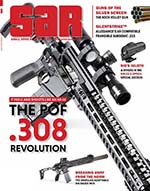Book Review: The Vetterli Rifle
By Dean Roxby
THE ITALIAN VETTERLI RIFLE: Development, Variants and History in Service
AUTHOR: ROBERT WILSEY
PUBLISHER: MOWBRAY PUBLISHING, WOONSOCKET, RI 02895 gunandswordcollector.com
ISBN: 1-931464-72-3
COPYRIGHT: 2016
PAGES: 168, HARDCOVER, COLOR DUST JACKET, 350+ PHOTOS AND ILLUSTRATIONS (MOSTLY IN COLOR), 8.5” x 11”
USD: $49.99
The Swiss-made infantry rifle adopted by the Italian Army
This book does a great job of explaining the history of an intriguing rifle. The Italian Vetterli rifle was issued in a surprising number of variants over its 40-year service life. Invented by Swiss citizen Johann-Friedrich Vetterli, it was first adopted by the Swiss military in 1869. Italy adopted a modified version the following year with the M1870.
The original Swiss version was a rimfire rifle, an odd choice when centerfire was already in use by that point. The Italian version was a centerfire design right from the beginning. Interestingly, the Swiss rimfire was a true repeater, with a tubular magazine built in, while the newer Italian centerfire was originally built as a single shot. Some years later, the Vetterli-Vitali 1870/87 magazine conversion appeared. Years later, during WWI, many rifles were rebarreled from the original 10.35x47R round to the newer 6.5x52mm Carcano cartridge. This was the 1870/87/15 series.
This book describes the various versions and sub-variants. Besides the standard issue versions, many rare experimental and limited issue variants are profiled in detail. Featuring crisp and clear color photographs, as well as beautiful artwork, this book really does a fine job of distinguishing one model from another. The artwork is provided by Guy and Leonard Alston-Roberts-West. The A-R-West brothers are well known among antique firearms collectors.
A detailed study of Nock’s form (rear end of the barrel, in the chamber area) markings and stock markings provides valuable information regarding factory codes and so on.
Bayonets, ammo pouches and other accessories and accoutrements are also examined at the end of Part One.
Part Two profiles the main arms factories in Italy that had a hand in Vetterli production or later conversions. There is a wonderful photo of an original display board showing the various steel parts that go into the mod. 1870/87 rifle. What makes this display so interesting is that the raw forgings are shown in stages as they go through the sequence of being forged and machined.
Part Three details Operational Service. This begins with the Italian campaigns in eastern Africa, mainly around modern-day Ethiopia, Eritrea and Somalia. Following this, the book details the strange paths that surplus military arms often took. For example, during World War I, the British wanted the Russian Empire to take a more active role in fighting Germany. The Russians were critically short of arms, so Britain proposed sending shiploads of obsolete and captured rifles including many Vetterlis. Before WWI was over, the Russian Revolution occurred, leading to the creation of the USSR. Years later, in 1936, the USSR sent many of these same arms to Spain during the Spanish Civil War. Vetterlis that made their way to Northern Ireland to arm the Ulster Volunteer Force are also covered.
A study of serial number ranges is covered in one of the appendices. This is based on the author’s notes from examining 456 individual rifles from all eras. The author freely admits that this is a tiny percentage of the 1.6 million produced, so some error should be expected.
The author, Robert Wilsey, served in the British Royal Marines for 31 years. His interest in the Vetterli stems from the time he spent stationed in Italy.
The entire catalogue of fine firearms and war history titles by Mowbray Publishing can be seen at www.gunandswordcollector.com.
This article first appeared in Small Arms Review V21N7 (September 2017) |
| SUBSCRIBER COMMENT AREA |
Comments have not been generated for this article.




